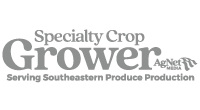
By Ute Albrecht, Carol Tardivo, Gabriel Pugina, Larissa Nunes, Jasmine de Freitas and Gerardo Moreno
Since the approval of oxytetracycline (OTC) injection to manage citrus greening (huanglongbing, HLB) in Florida, the University of Florida Institute of Food and Agricultural Sciences (UF/IFAS) plant physiology team at the Southwest Florida Research and Education Center (SWFREC) has completed various research trials with multiple years of observations in different commercial production environments. In nearly all field trials, trees improved significantly in response to the injections in terms of fruit yield, fruit quality and juice quality. This article summarizes the most important findings and lessons learned from completed and ongoing studies.
TREE AGE AND VARIETIES
Field trials were conducted on trees ranging in age from 4 to 18 years. Regardless of the age, trees responded positively to the injections. Generally, larger relative increases in fruit yield were observed for younger trees (4 to 6 years old) than for older trees. Depending on the OTC rate, young trees responded with up to three-fold increases in yield. Responses in trials with 6- to 12-year-old trees and 18- to 19-year-old trees ranged from 25% to 60%. When two years of injections were completed, increases were even higher.
Aside from tree age, tree responses were affected by the location of the trial, grove care, scion and rootstock variety, and other factors. Most trials were conducted with Valencias, but Hamlins and Duncan grapefruits also responded positively to the injections.
APPLICATION RATES
The term ‘rate’ is often referred to as the concentration of OTC [e.g., 5,500 parts per million (ppm) or 11,000 ppm], which does not indicate the actual amount of OTC a tree receives. For example, if 100 milliliters of a 5,500 ppm or 11,000 ppm OTC solution is injected, the amount of OTC the tree receives is 0.55 or 1.1 grams, respectively. If only 50 milliliters is injected of either solution, the tree receives 0.275 or 0.55 gram of OTC, respectively. To avoid confusion, ‘rate’ is expressed here as the amount (grams) of OTC delivered per tree per year.
For young trees, the responses to the injections were better the more OTC was injected. For example, when trees received 0.15 gram of OTC per year, the yield increased by 20% to 40%. But when they received 0.75 gram of OTC per year, the yield doubled or tripled in comparison to non-injected trees. The same principle applied to the fruit and juice quality: More OTC resulted in a larger fruit size, a better peel color, a better juice color, a higher Brix and a higher Brix/acid ratio.
In older trees, higher rates (1.1 to 1.65 grams of OTC) generally resulted in higher yields and better juice quality than lower rates (0.55 to 0.825 gram of OTC), but differences among rates were not prominent. However, when the amount of OTC per tree was divided into two or three portions and delivered evenly spaced around the trunk, the efficacy increased considerably, regardless of the rate. This means that injecting smaller amounts of OTC on two (or more) sides of the trunk is more effective than injecting a large amount on only one side of the trunk.
In 18-year-old Hamlin and Valencia trees, injection of 0.825 gram of OTC each on two opposite sides of the trunk (1.65 grams of OTC per tree total) increased fruit yield by 32% (Hamlin) and 48% (Valencia). The pounds solids per box of fruit increased from 4.3 to 4.9 (Hamlin) and from 4.4 to 5.1 (Valencia).
Higher OTC rates increased the amount of OTC detected in the (whole) fruits at harvest. Residues were below the maximum allowed tolerance when injections were completed by June and the interval between injection and harvest was 180 days or longer. The maximum allowed tolerance of OTC administered by injection is 10 parts per billion.
INJECTION TIMING, METHOD AND LOCATION
Injections that were administered in different months (March to September) were all effective. In fact, injecting later in the year resulted in a higher Brix than injecting earlier. However, when injections were performed in August or September, OTC residues in the fruit increased considerably, even when there were 180 days between injection and harvest. It is therefore advised to have all injections completed by July.
When comparing injections using syringe-type injectors (e.g., Chemjet Tree Injectors) and FLexInject injectors, both produced equal results in terms of yield and fruit/juice quality.
Regarding trunk injury, injectors with smaller tips are preferred, especially for young trees. Two sizes of tips are available for the FLexInject injectors, requiring a 13/64-inch or a 17/64-inch drill bit. Chemjet injectors are used with an 11/64-inch drill bit. When injecting young trees, a smaller drill bit will cause considerably less trunk injury (like bark cracking) than a larger one. Recurring injections should never be performed into the same injection site.
Although both scion and rootstock injection are effective in terms of yield and fruit quality, injecting into the scion may result in a higher frequency of bark cracking and longer cracks than injecting into the rootstock. This is especially true for young trees. Aside from genetic differences between scion and rootstock, the smaller diameter of the scion may be the main reason for the higher incidence of cracking.
Older trees exhibit considerably less bark cracking, regardless of whether injections are performed into the scion or rootstock. When the trunk of the tree is short, injections are better made into the rootstock to give the OTC more time to disperse before reaching the scaffold branches, thus reducing sectoring.
OTHER FINDINGS
Phytotoxic effects (mostly leaf yellowing) were observed in response to injection in some but not all trials, regardless of the month in which they were performed. Most phytotoxic effects were moderate and only temporary. Severe effects, like leaf and fruit drop, were rare and restricted to small sectors of the canopy (those closest to the injection site).
Although not eliminated, phytotoxicity was reduced when the OTC was delivered in two portions on opposite sides of the trunk. Administering smaller amounts of OTC on two or three points around the trunk also reduced sectoring.
Phytotoxicity is not related to the pH of the solution. The solubility of the OTC decreases greatly above a pH of 2, and the dissolved OTC deteriorates within hours, especially under hot conditions.
Lastly, it must be kept in mind that bacterial reductions caused by one injection are not permanent. Controlling the psyllid vector remains essential for HLB management. Naturally, good tree care is important to prepare trees for injection and to help with recovery.
Acknowledgments: The authors thank the Citrus Research and Development Foundation and U.S. Department of Agriculture National Institute of Food and Agriculture for financial support.
Ute Albrecht (ualbrecht@ufl.edu) is an associate professor; Caroline Tardivo, Gabriel Pugina and Larissa Nunes are Ph.D. candidates; and Jasmine de Freitas and Gerardo Moreno are biological scientists, all at the UF/IFAS SWFREC in Immokalee.
Share this Post
Sponsored Content










